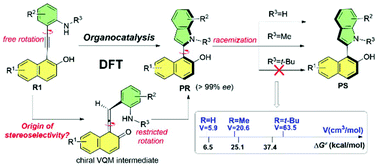Origin and stabilization of axial chirality in the construction of naphthyl-C2-indoles: a DFT study†
Abstract
The origin and maintenance of axial chirality in the construction of naphthyl-C2-indoles, via the asymmetric annulation of ortho-alkynylaniline catalyzed by a chiral Brønsted base (cinchonine–thiourea), have been systematically explored using density functional theory (DFT). Several key processes are included in the general mechanism of this kind of reaction: hydrogen bond adsorption of the ortho-alkynylaniline by a catalyst, proton transfer for forming an ortho-quinone methide (VQM) intermediate, intramolecular cyclization, and release of the catalyst to generate R- or S-axial-chiral aryl-C2-indole skeletons. The stereoselectivity-determining steps were identified, and the calculated results show that the pathway associated with the R-configurational isomer has the lower energy barrier, so the corresponding product should be the main one. Non-covalent interaction and atom-in-molecule analyses indicate that N–H⋯O, C–H⋯π and π⋯π interactions play important roles in controlling the stereoselectivity. Multiple processes and different substituents were employed to compute the energy barriers for transformation between R- and S-configurational isomers, revealing that the volume of the substituents is key for maintaining high axial chirality. The obtained insights into the origin for generating and stabilizing the high axial chirality is valuable for the rational design of more efficient organocatalytic reactions.



 Please wait while we load your content...
Please wait while we load your content...